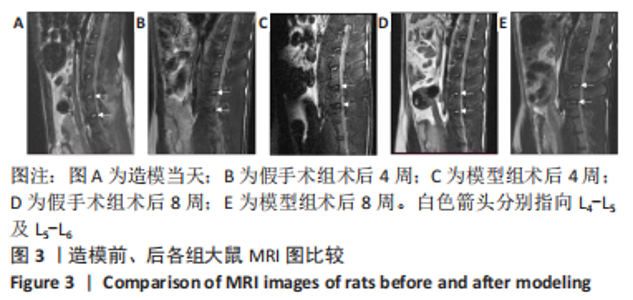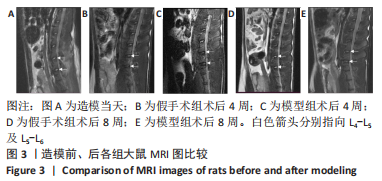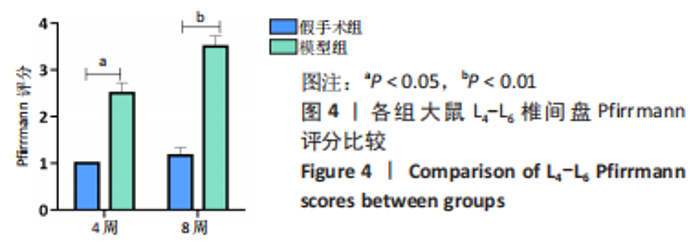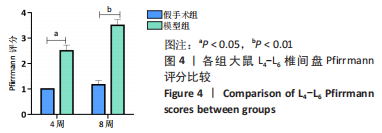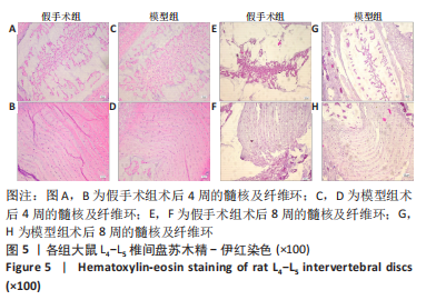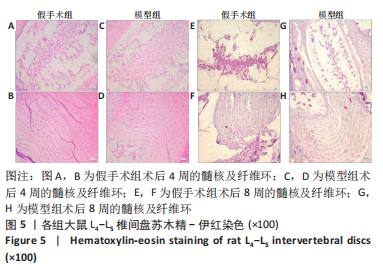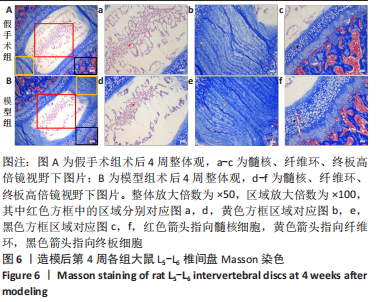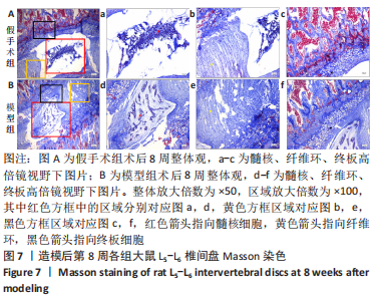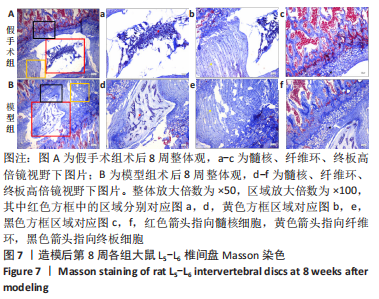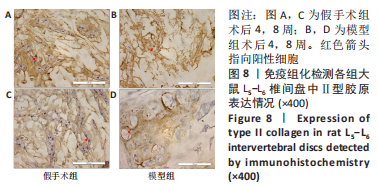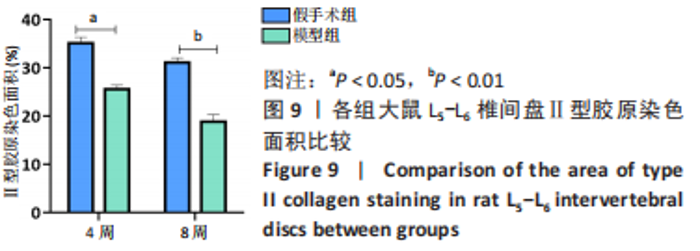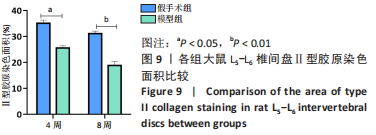[1] KNEZEVIC NN, CANDIDO KD, VLAEYEN JWS, et al. Low back pain. Lancet. 2021;398(10294):78-92.
[2] SUDO T, AKEDA K, KAWAGUCHI K, et al. Intradiscal injection of monosodium iodoacetate induces intervertebral disc degeneration in an experimental rabbit model. Arthritis Res Ther. 2021;23(1):297.
[3] BOREM R, WALTERS J, MADELINE A, et al. Characterization of chondroitinase-induced lumbar intervertebral disc degeneration in a sheep model intended for assessing biomaterials. J Biomed Mater Res A. 2021;109(7):1232-1246.
[4] 白荣飞,张震,林一峰,等.三种方法建立大鼠腰椎间盘退变模型[J].中国组织工程研究,2018,22(16):2514-2519.
[5] LIANG QQ, ZHOU Q, ZHANG M, et al. Prolonged upright posture induces degenerative changes in intervertebral discs in rat lumbar spine. Spine (Phila Pa 1976). 2008;33(19):2052-2058.
[6] LIANG QQ, CUI XJ, XI ZJ, et al. Prolonged upright posture induces degenerative changes in intervertebral discs of rat cervical spine. Spine (Phila Pa 1976). 2011;36(1):E14-E19.
[7] CHE YJ, GUO JB, LIANG T, et al. Assessment of changes in the micro-nano environment of intervertebral disc degeneration based on Pfirrmann grade. Spine J. 2019;19(7):1242-1253.
[8] KAMEI N, NAKAMAE T, NAKANISHI K, et al. Evaluation of intervertebral disc degeneration using T2 signal ratio on magnetic resonance imaging. Eur J Radiol. 2022;152:110358.
[9] GULLBRAND SE, MALHOTRA NR, SCHAER TP, et al. A large animal model that recapitulates the spectrum of human intervertebral disc degeneration. Osteoarthritis Cartilage. 2017;25(1):146-156.
[10] FLOUZAT-LACHANIETTE CH, JULLIEN N, BOUTHORS C, et al. A novel in vivo porcine model of intervertebral disc degeneration induced by cryoinjury. Int Orthop. 2018;42(9):2263-2272.
[11] TELLEGEN AR, RUDNIK-JANSEN I, BEUKERS M, et al. Intradiscal delivery of celecoxib-loaded microspheres restores intervertebral disc integrity in a preclinical canine model. J Control Release. 2018;286:439-450.
[12] BEIERFUß A, DIETRICH H, KREMSER C, et al. Knockout of Apolipoprotein E in rabbit promotes premature intervertebral disc degeneration: A new in vivo model for therapeutic approaches of spinal disc disorders. PLoS One. 2017;12(11):e0187564.
[13] GLAESER JD, SALEHI K, KANIM LEA, et al. NF-κB inhibitor, NEMO-binding domain peptide attenuates intervertebral disc degeneration. Spine J. 2020;20(9):1480-1491.
[14] GORTH DJ, SHAPIRO IM, RISBUD MV. A New Understanding of the Role of IL-1 in Age-Related Intervertebral Disc Degeneration in a Murine Model. J Bone Miner Res. 2019;34(8):1531-1542.
[15] O’CONNELL GD, VRESILOVIC EJ, ELLIOTT DM. Comparison of animals used in disc research to human lumbar disc geometry. Spine (Phila Pa 1976). 2007;32(3):328-333.
[16] 杨光露,郭杨,马勇,等.扶阳宣痹汤对大鼠椎间盘退变及基质金属蛋白酶表达的影响[J].中国中医骨伤科杂志,2021,29(4):1-7.
[17] HASEGAWA T, KATSUHIRA J, OKA H, et al. Association of low back load with low back pain during static standing. PLoS One. 2018;13(12): e0208877.
[18] HUTTON WC, MURAKAMI H, LI J, et al. The effect of blocking a nutritional pathway to the intervertebral disc in the dog model. J Spinal Disord Tech. 2004;17(1):53-63.
[19] YIN S, DU H, ZHAO W, et al. Inhibition of both endplate nutritional pathways results in intervertebral disc degeneration in a goat model. J Orthop Surg Res. 2019;14(1):138.
[20] LAO YJ, XU TT, JIN HT, et al. Accumulated Spinal Axial Biomechanical Loading Induces Degeneration in Intervertebral Disc of Mice Lumbar Spine. Orthop Surg. 2018;10(1):56-63.
[21] 郭小惠,宋西正,韩枕学,等.可控压缩应力轴向诱导山羊椎间盘退变模型构建及评价[J].医用生物力学,2021,36(2):224-230.
[22] LIU S, SUN Y, DONG J, et al. A Mouse Model of Lumbar Spine Instability. J Vis Exp. 2021;(170). doi: 10.3791/61722.
[23] KONG M, ZHANG Y, SONG M, et al. Myocardin‑related transcription factor A nuclear translocation contributes to mechanical overload‑induced nucleus pulposus fibrosis in rats with intervertebral disc degeneration. Int J Mol Med. 2021;48(1):123.
[24] CHEN S, WU X, LAI Y, et al. Kindlin-2 inhibits Nlrp3 inflammasome activation in nucleus pulposus to maintain homeostasis of the intervertebral disc. Bone Res. 2022;10(1):5.
[25] HE R, WANG Z, CUI M, et al. HIF1A Alleviates compression-induced apoptosis of nucleus pulposus derived stem cells via upregulating autophagy. Autophagy. 2021;17(11):3338-3360.
[26] 李凯明,朱立国,李玲慧,等.补肾活血方对兔退变椎间盘模型经典Wnt/β-catenin信号通路的影响[J].中华中医药杂志,2020,35(12): 6001-6005.
[27] WANG Y, WU Y, DENG M, et al. Establishment of a Rabbit Intervertebral Disc Degeneration Model by Percutaneous Posterolateral Puncturing of Lumbar Discs Under Local Anesthesia. World Neurosurg. 2021;154: e830-e837.
[28] DING SL, ZHANG TW, ZHANG QC, et al. Excessive mechanical strain accelerates intervertebral disc degeneration by disrupting intrinsic circadian rhythm. Exp Mol Med. 2021;53(12):1911-1923.
|
